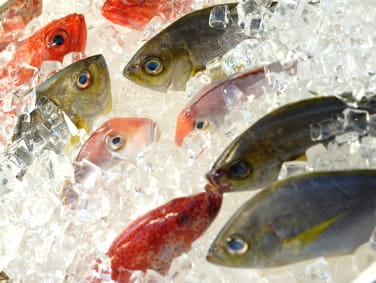Food Poisoning from Fish: Scombroid What You Can't Smell Can Hurt

The Bottom Line
Scombroid poisoning occurs when people eat fish that were not properly stored. The appearance and taste of the fish is usually normal and cooking or freezing the fish cannot prevent scombroid. Scombroid poisoning can be scary and uncomfortable, but most people recover with simple treatment.

The Full Story
What you can't smell can't hurt you, right? Wrong! Eating certain fish that have not been properly stored can cause dramatic symptoms.
Scombroid poisoning happens when people consume certain types of fish that have not been refrigerated properly from the time they were caught until the time they were served. The most common fish responsible for scombroid poisoning are tuna, mahi-mahi, mackerel, amberjack, and herring, although many other types of fish can cause scombroid. Bacteria act on compounds in the fish meat, forming histamine, the chemical that is responsible for causing allergies and allergic reactions. When people eat the fish, they consume a large amount of histamine that is absorbed into the bloodstream. This accounts for the allergic-type symptoms that occur with scombroid poisoning, and also explains why antihistamines help control the symptoms.
Symptoms of scombroid fish poisoning begin quickly, within about 15 minutes to 2 hours after eating the fish. Most people experience some combination of flushing and rash on the face and upper body, sweating, diarrhea, vomiting, and abdominal cramps. Scombroid poisoning is uncomfortable, and some individuals may require treatment in a hospital for dehydration or other symptoms. However, most people recover quickly without treatment, and symptoms are usually gone within 12 to 24 hours. Home treatment for mild to moderate symptoms includes taking over-the-counter antihistamines such as diphenhydramine (Benadryl®) and drinking fluids to prevent dehydration. More serious symptoms of trouble breathing, swelling of the tongue and mouth, and chest pain, require treatment in an emergency room with antihistamines. In severe cases, people may become dehydrated and need treatment with nausea medications or intravenous fluids. While scombroid has many symptoms similar to an allergic reaction, scombroid food poisoning does not mean you are allergic to a particular fish.
A person who catches his or her own fish must be careful to keep the fish refrigerated at all times, at a temperature no higher than 40 degrees Fahrenheit. There is no other reliable way to prevent scombroid poisoning. Scombroid cannot be prevented by cooking or freezing the fish. In a restaurant or store, it is impossible to know for sure if a fish has been properly stored during its entire journey from the water. Scombroid generally is not detectable by taste or smell. But if a fish tastes peppery, or the skin has a honeycomb appearance, do not eat it! If anyone develops symptoms of scombroid poisoning from a store or restaurant, be sure to let the facility and the health department know. That might prevent someone else from becoming sick from eating the same fish.
For questions about scombroid poisoning, or if you think someone is having a reaction to fish, use the webPOISONCONTROL® online tool or call 1-800-222-1222. Both options are free for the public, and available 24 hours a day.
Rose Ann Gould Soloway, RN, BSN, MSEd, DABAT emerita
Clinical Toxicologist
Maryann Amirshahi, PharmD, MD, MPH, PhD
Medical Toxicologist
Poisoned?
Call 1-800-222-1222 or
Prevention Tips
-
Keep fish refrigerated from the time the fish is caught until it’s cooked and eaten.
- Don’t let freshly caught fish sit in the sun on a boat, dock, or beach.
-
When ordering or eating fish at restaurants, be aware of which fish are more likely to cause scombroid poisoning.
This Really Happened
While on her honeymoon at a fancy Caribbean resort, a physician ordered mahi-mahi for dinner. During the dessert course, she began to have abdominal cramping and nausea. She ran to the bathroom, where she vomited several times. When she looked up from washing her face in the sink, she noticed that her face was beet red and flushed. Her new husband took her to the resort’s nurse, who provided Benadryl®. The resort’s nurse also called the restaurant to alert them about the fish poisoning and advised them to stop serving it to prevent other guests from getting sick. By the next morning, the physician felt better, but she avoided eating mahi-mahi for years after that experience.
References
Poisoned?
Call 1-800-222-1222 or
Prevention Tips
-
Keep fish refrigerated from the time the fish is caught until it’s cooked and eaten.
- Don’t let freshly caught fish sit in the sun on a boat, dock, or beach.
-
When ordering or eating fish at restaurants, be aware of which fish are more likely to cause scombroid poisoning.
This Really Happened
While on her honeymoon at a fancy Caribbean resort, a physician ordered mahi-mahi for dinner. During the dessert course, she began to have abdominal cramping and nausea. She ran to the bathroom, where she vomited several times. When she looked up from washing her face in the sink, she noticed that her face was beet red and flushed. Her new husband took her to the resort’s nurse, who provided Benadryl®. The resort’s nurse also called the restaurant to alert them about the fish poisoning and advised them to stop serving it to prevent other guests from getting sick. By the next morning, the physician felt better, but she avoided eating mahi-mahi for years after that experience.
